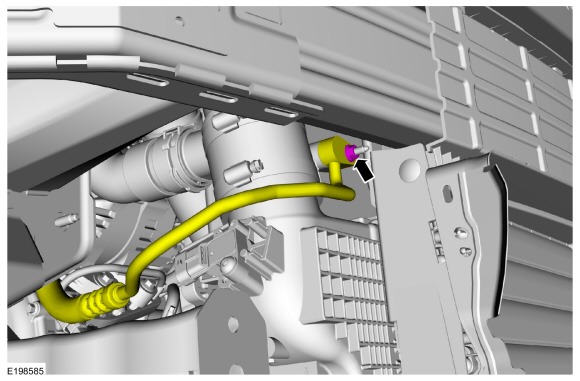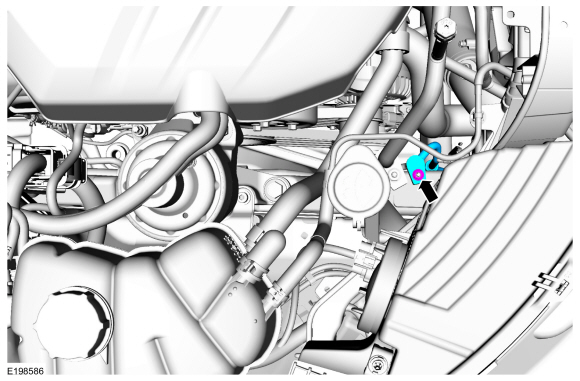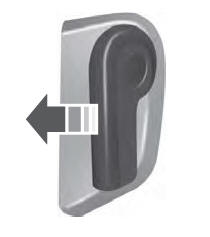Lincoln Nautilus: Climate Control System - General Information / Condenser Outlet Line - 2.0L EcoBoost (184kW/250PS) – MI4. Removal and Installation
Lincoln Nautilus 2018-2025 Service Manual / Electrical / Climate Control System / Climate Control System - General Information / Condenser Outlet Line - 2.0L EcoBoost (184kW/250PS) – MI4. Removal and Installation
Removal
NOTICE: During the removal of components, cap, tape or otherwise appropriately protect all openings to prevent the ingress of dirt or other contamination. Remove protective materials prior to installation.
NOTE: Removal steps in this procedure may contain installation details.
-
Recover the refrigerant. Refer to the appropriate Recovery procedure in Group 412.
-
Remove the front bumper cover.
Refer to: Front Bumper Cover (501-19 Bumpers) .
-
Remove the condenser outlet line nut and disconnect the fitting.
-
Make sure to cover any open ports to prevent debris from entering the system.
Torque: 80 lb.in (9 Nm)
-
Make sure to cover any open ports to prevent debris from entering the system.
 |
-
Remove the condenser outlet line nut, disconnect the fitting and remove the condenser outlet line.
-
Make sure to cover any open ports to prevent debris from entering the system.
Torque: 80 lb.in (9 Nm)
-
Make sure to cover any open ports to prevent debris from entering the system.
 |
Installation
-
To install, reverse the removal procedure.
-
NOTICE: Only use the specified material to lubricate the seals.
Install and lubricate new O-ring seals. Refer to the appropriate Specifications in Group 412.
-
Lubricate the refrigerant system with the correct amount
of clean PAG oil. Refer to the appropriate Refrigerant Oil Adding
procedure in Group 412.
 Condenser - 2.0L EcoBoost (184kW/250PS) – MI4. Removal and Installation
Condenser - 2.0L EcoBoost (184kW/250PS) – MI4. Removal and Installation
Removal
NOTE:
Removal steps in this procedure may contain installation details.
Remove the cooling module.
Refer to: Cooling Module (303-03A Engine Cooling - 2...
 Driver Side Footwell Air Discharge Temperature Sensor. Removal and Installation
Driver Side Footwell Air Discharge Temperature Sensor. Removal and Installation
Removal
Remove the climate control housing.
Refer to: Climate Control Housing (412-00 Climate Control System - General Information, Removal and Installation)...
Other information:
Lincoln Nautilus 2018-2025 Service Manual: Information and Entertainment System - System Operation and Component Description. Description and Operation
System Operation Audio System Overview NOTE: Refer to the Owner Literature for additional details of the audio system. AM / FM Radio The ACM can be operated when the ignition is on or off. The accessory delay feature powers the audio system, after the ignition has been turned off, for a preset time or until a front door is opened...
Lincoln Nautilus 2018-2025 Owners Manual: Checking the Tire Pressures. Inflating the Tires
Checking the Tire Pressures Safe operation of your vehicle requires that your tires are properly inflated. Remember that a tire can lose up to half of its air pressure without appearing flat. Every day before you drive, check your tires. If one looks lower than the others, use a tire gauge to check the pressure of all tires and adjust if required...
Categories
- Manuals Home
- 1st Generation Nautilus Owners Manual
- 1st Generation Nautilus Service Manual
- Anti-Theft Alarm System Settings. Security – Troubleshooting
- Changing the 12V Battery
- Interior Lamp Function. Adjusting the Instrument Panel Lighting Brightness. Ambient Lighting. Interior Lighting – Troubleshooting
- New on site
- Most important about car
Opening and Closing the Hood
Opening the Hood

Copyright © 2025 www.linautilus.com
